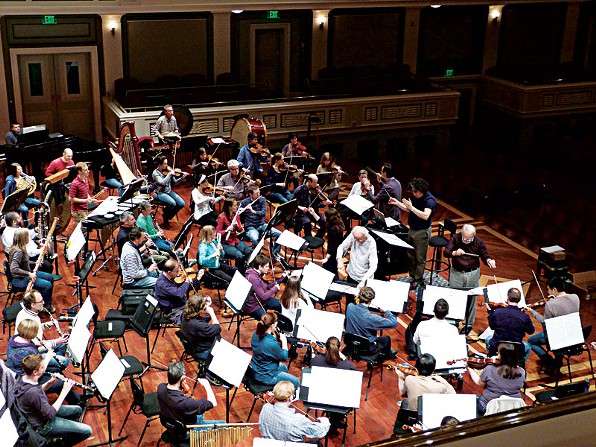|
Back
Cosmic Conceptions New York
Isaac Stern Auditorium, Carnegie Hall
05/12/2012 -
“Spring For Music V”
Charles Ives: Universe Symphony (realized and completed by Larry Austin) (New York Premiere)
Terry Riley: The Palmian Chord Ryddle (New York Premiere)
Percy Grainger: The Warriors
Tracy Silverman (Electric Violin), Gyan Riley (Banjo)
Nashville Symphony, Kelly Corcoran (Associate Conductor), Albert-George Schram (Resident Conductor), Larry Austin (Guest Conductor), Giancarlo Guerrero (Music Director)

Conductors and Nashville Symphony (© Nashville Symphony)
”In the Beginning were the ‘Incessant Myriads.’”
No Big Bang Theory for that crusty old Transcendentalist Charles Ives, though he doubtless would have affirmed that a Big Bang incorporates endless, eternal and still ensuing Small Bangs. Most of that cosmic creation process, in fact, was sounded, amidst the incessant myriads of music last night by the Nashville Symphony.
The Nashville Symphony, almost 70 years old, gave the finale of “Spring For Music”, a two-year-old Carnegie Hall Tradition, which hopefully will go on as long as our Universe goes on. For no matter what the size of the ensembles or their place in the world, each of these five visiting groups showed vibrant personalities while taking on sometimes unplayable music.
And the Nashville Symphony was no exception. Unlike most of the other orchestras, this group from Music City is massive in players (over 100, including guests last night) and in sounds. This was no surprise, since their legendary last conductor, Kenneth Schermerhorn was originally a trumpet player, and he enjoyed the grand aural dimensions.
Schermerhorn was a committed Ivesian, so it was no surprise that the splendid Nicaraguan/Costa Rican conductor Giancarlo Guerrero should take up the cudgels for the opening work in Carnegie Hall.
Like the opening concert’s Nocturnal, Universe is only partly that of the composer. Nocturnal was finished by Chou Wen-chung. Paul Austin (one of the conductors last night) took Ives’ 34 pages of notes (musical and verbal), sketches, scribbles and poetic ideas, to create a 30-odd minute piece.
Ives wanted the music to come from different mountain tops (ŕ la Scriabin), but Austin simply divided the orchestra into seven “mini”-orchestras on stage, with four different conductors and a computer for the major conductor to work on.
So far, so good. But the Ives-Austin combination didn’t stop there. According to the program notes, Ives needed “20 percussion members, each performing in a different meter and a different tempo coming into metric phrase every eight seconds...two macro-layers…four ‘heavens’ orchestras...” Austin then composed this with “22 different meters and tempos.”
Whew!!
The result was far far more subtle than it would seem. Yes, the final movement gave out with all the crashes and mammoth sounds one would expect. But for the most part, the success of this Symphony is what we don’t hear in the complicated musical arena.
The first movement, in fact, is awfully quiet, one scale-like motive repeated over and over again, the percussion adding up like a reluctant fugue, until the entire battery has developed it, used it, forced it upon us. The second movement (“Evolution in nature and humanity”) also holds its forces, relatively speaking, until the great ending.
The effect, though, is like a pointillistic painting. On first hearing, it sounds like a full huge orchestra making a full huge sound. But one has the tine (if not hypnotized by the repetition) to listen to the individual parts, every single instrument playing something different, at different times and meters, with the four conductors in different sections of the orchestra, led by a computer-reading Giancarlo Guerrero making sense of it all.
Despite its name (only a modest gentleman would christen it Universe Symphony), it is hardly the noisiest Ives around. For that distinct pleasure –and I mean it literally–, we must wait for May 10, 2013, when Leonard Slatkin will lead the Detroit Symphony Orchestra is all four Ives symphonies.
My ticket request is already prepared.

T. Riley, T. Silverman (© Courtesy of Mr. Silverman)
One of Nashville’s most celebrated “immigrants”, Tracy Silverman, made his entrance after the intermission with a new work by Terry Riley, written for him.
John Adams and Terry Riley are only two of the composer enticed to compose for Silverman’s six-string electric violin. And for good reason. Silverman is an accomplished enough violinist on his own. But as somebody said, “he entered Juilliard like another Heifetz and graduated like another Hendrix.
For that, he needed his own instrument. Simply enough, he added two more strings to the conventional violin, to achieve the lowest mellow cello-like notes, and connected an amplifier, so that the notes could be distorted, harmonized coming out like a whole string quartet.
Which has allowed Mr. Silverman to play with rock, classical, punk, Indian and everything in between.
One would have imagined that the Riley work, commissioned by the Nashville Symphony, would have been ragged, Country, wild and brash. But Riley’s work, while overlong, used Mr. Silverman’s fiddle to take us on a trip from a modal opening through a dance, through Kerala-Indian rhythms, up to a very quiet, even touch moment to finish.
Riley is a most accomplished composer, and an inventive one. But this piece had so much invention that the mind drifted off for a bit, though never from Mr. Silverman’s extraordinary skills on his own instrument.
The final piece was by that Nordic-supremacist, Aussie-born unabashed atheist, autodidact virtuoso pianist with an ego that would make Wagner seem like a shrinking violet. Percy Aldridge Grainger, in his 80 years on this planet, became a greater personal eccentric than the music which he thought to be eccentric.
Some of the piano works do indeed verge on the avant-garde, but his “music to an imaginary ballet”, The Warriors, is hardly in that class. Warriors needs a huge orchestra (enter the Nashville Symphony), great playing and difficult orchestral balances. The music itself is essentially grandiloquent Edwardian fluff. (It was composed the same year Stravinsky wrote Petrushka and Ives started Universe Symphony.) Still, lots of tonic-dominant fun. And Maestro Guerrero conducted it with all the exuberance it needed. For the Nashville Symphony has the forces, the enthusiasm, and the musicians to project what Grainger would have wanted most, a slam-bang finale.
Harry Rolnick
|